Russian Black Terrier
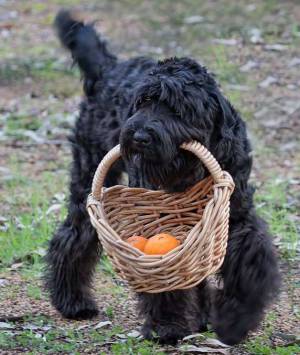 Black Russian Terrier
Black Russian Terrier
Formerly called 'Black Russian Terrier, the Russian Black Terrier was secretly bred behind the Iron Curtain to become the "ultimate four-legged soldier". Beginning around the mid-1900s, Russian dictator Joseph Stalin founded the 'Red Star' kennel which aimed to create a large, high-spirited military dog with a stable temperament. This dog would always be willing and able to work whilst withstanding the dramatic climatic variations experienced within Russia.
Today the Russian Black Terrier is handsome, dignified and confident yet amiable and friendly; smart and undemanding yet not dominant. It not only fits superbly into modern society, it also successfully competes in a variety of modern disciplines including obedience, agility and activity that requires intensive training.
History of the Russian Black Terrier
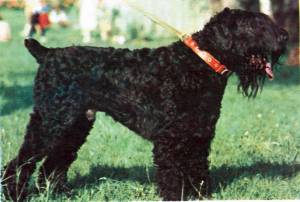 Black Russian Terrier in Russia pre-1990
Black Russian Terrier in Russia pre-1990
From 1949 to 1991, physical structures collectively called 'the Iron Curtain' isolated Russia and other Communist countries in the Soviet Union economically and politically. During this time, the Russian Black Terrier we know today was developed for the 'Red Army' under the orders of the Soviet Union's leader, Joseph Stalin.
This development began in 1950 when General Medvevdev, the head of the central school of military, visited Stalin and presented him with a plan to genetically create a dog that would be 'the ultimate fighting companion'.
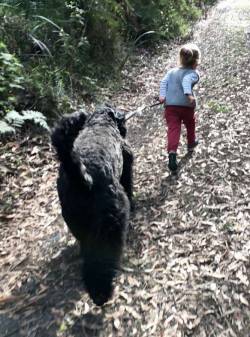 Russian Black Terrier with child
Russian Black Terrier with child
He recommended that it should be:
- Black so it would not be detected
- Have a coat that would protect the dog in all weathers,
- Have eye coverings that protected the eyes against snow blindness,
- Have legs sufficiently strong to propel the dog through snow drifts
- Have webbed feet like snow-shoes sufficiently strong to dig out victims of a disaster.
Soon after Stalin considered the plan, he ordered funds for the immediate development of the idea. Medvevdev then began to work with a group of scientists. Consequently interbreeding began by mixing wolf-like dogs from Siberia with the following breeds selected because they displayed desired characteristics. These were:
- The Schnauzer (Giant) selected because of its agility and working ability
- The Rottweiler selected for its courage, temperament and again its working ability
- The Newfoundland selected for its loyalty, size and coat
- The Airedale Terrier selected for its spirit and ability to hunt
- Local breeds like the Livestock Guardian dog, the Caucasian Ovcharka and the excellent swimmer, the 'Moscow Diving Dog' for more specialized traits.
 Black Russian Terrier
Black Russian Terrier
Over the next two years, more than 800 different litters were produced. By the 1970s scientists had sufficient numbers of dogs from which to establish the powerful dog we know today. It weighed around 50 kilos, was hard working and reliable, was extremely loyal and had a thick double coat which enabled it to work in all terrains. In other words, it was suitable to join the 'Red Army'!
The Russian Black Terrier Becomes a Pure Breed
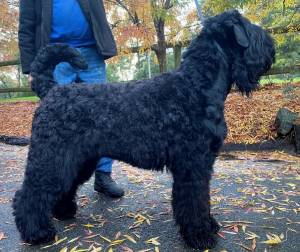 A young Black Russian Terrier
A young Black Russian Terrier
In May 1984, the 'Black Russian Terrier' was recognized by the FCI with Breed Standard #327 and released to the general public. In 1986, these dogs were decorated for their bravery when used to dig out victims of the Chernobyl nuclear disaster. Despite their 'secret' status as time went by, a number of puppies were given away and became favourites of Russian households.
In 1991, the Iron Curtain came down, opening the door for the Black Russian Terrier to be exported. Englishwoman, Violet Slade brought the first pair into Britain, she described them as:'
the most ruthlessly and cleverly bred dog ever known and yet its very existence has been shrouded in secrecy for half a century'
Because of this, it took until October, 1997 for Violet Slade's dream of owning a Black Russian Terrier from Soviet Russia in England to finally came true! This is her story:
The Black Russian Terrier arrives in the UK
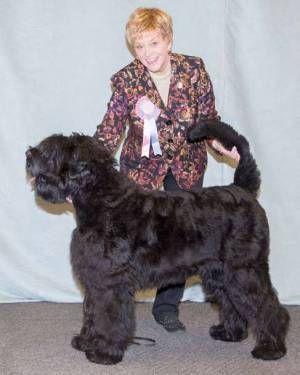 Violet with one of her Black Russian Terriers
Violet with one of her Black Russian Terriers
A teacher Violet had befriended when she was in Russia, arranged to purchase two Russian Black Terrier pups on her behalf. These were 8-week-old 'Ludwic' and 12-week-old 'Nina'. He put them into a large wooden box labelled 'Moscow State Circus' and took them to one of the Russian Airports. Violet also arranged for her vet to meet the plane when it arrived at Heathrow Airport in London. When the officials demanded the box be opened, the vet convinced them that the pups were Poodle showdogs. The vet then successfully oversaw the difficult job of supervising humongous amount of paperwork, and gave the pups a clean bill of health.
After four days, the English authorities allowed the pups to proceed with the normal six-months quarantine. Two years later, in 1999, the original two Black Russian Terriers had a litter of eleven pups from which 'Cleyra', Violet's first Black Russian Terrier was selected on which to establish the breed in UK[1].
History of the Russian Black Terrier in Australia
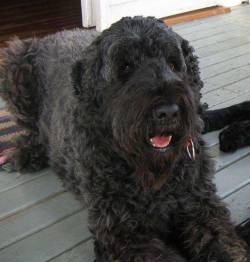 Russian Black Terrrier "Zaya'
Russian Black Terrrier "Zaya'
In 2001, the Russian Black Terrier was established in Queensland, Australia by passionate dog trainers, Dot and Ross Sweeney. With no intention of bringing showdogs, they selected dogs based on their temperament and working lines. Because of the stigma of bringing in dogs from Russia, the dogs Dot and Ross purchased were domiciled in Finland which of course shares a border with Russia. Additionally, because Australia was (and still is) a rabies-free country, in order to satisfy Australia's requirements, a humongous amount of paperwork plus a six-months quarantine period was required in order to import dogs.
Consequently, arrangements were made with a kennel in Finland to import a Russian bitch called 'Best Guard Deniza' ("Zaya") into Australia. She was able to do her 6-months quarantine in Finland. Conveniently, whilst doing this quarantine, she came into season. Consequently, arrangements were made to mate her to a suitable Russian Dog 'Zornoi Buran' who lived in Finland. The result was that "Zaya" arrived pregnant and produced a beautiful litter of eleven pups soon after arrival in Queensland, bred under the Australian prefix 'Cimarron".
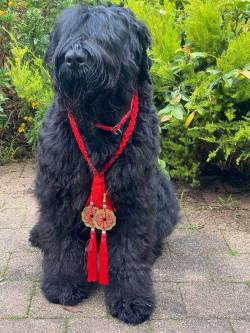 Russian Black Terrier
Russian Black Terrier
The Name Changes
In the early 2,000's in line with the world's other controlling bodies like FCI, AKC, and the KC (UK), the name was changed from the 'Black Russian Terrier' to the 'Russian Black Terrier'. The reason was probably so the country of origin would come first. However, it could also have been to avoid confusion with the Black Russian cocktail drink made of vodka and coffee liqueur.
The Russian Black Terrier Today
The Russian Black Terrier is a large, robust athletically built dog with a body slightly longer than its height at withers. Always black in colour, it is permissible for grey hair to intermingle with the black as long as it does not cover more one third of the body.
 Russian Black Terrier competing for a 'Working Weight Pull Dog' Title
Russian Black Terrier competing for a 'Working Weight Pull Dog' Title
A large dog, the males stand 72 - 76 cms (28 - 30 ins) tall but not less than 70 cm (27 ins) and not more then 78 cm (31 ins). Their weight should be 50 - 60 kg (110 - 132 lbs). The bitches should stand 68 - 72 cms (68 - 28ins) and be less than 66 cms (26 ins.) but not more than 74 cms (29 ins). Their weight should be 45 - 50 kgs (99- 110 lbs).
The Russian Black Terrier moves with a free and balanced energetic trot with long strides which come from the powerful rear drive of its hindquarters. This is balanced by significant strength in the forequarters and firm topline. This large size combined with the dog's general athleticism enables it to successfully compete in a wide range of activities including the Weight Pull pictured.
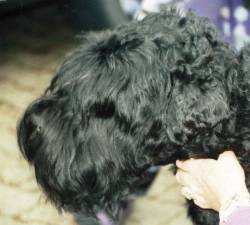 Russian Black Terrier Profile
Russian Black Terrier Profile
Head
The large head should be massive and strong. The skull should be moderately broad and flat with parallel head planes. The arches over the eyes are moderately pronounced, making the eyes look deep set. The occipital bone is moderately pronounced, the cheeks rounded but not pronounced and the stop moderate.
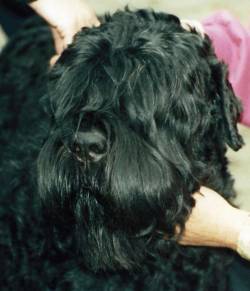 Russian Black Terrier
Russian Black Terrier
The nose is large and black and the broad, strong muzzle should be slightly shorter than the skull. The voluminous hair that forms the moustache and beard accentuates the volume of the muzzle and gives it a rectangular, blunt appearance.
The thick, pigmented lips are dark. The oval shaped dark eyes are of medium size and are set wide apart. The dropped ears are triangular in shape and are set close to the cheek, and have dense leathers, without folds. The large, strong teeth form a normal scissors bite with full dentition.
Body
 Russian Black Terrier
Russian Black Terrier
The length of the neck should be equal to the length of the head. The forelegs should be straight and parallel and equal to the dog's height at withers. The shoulder blades should be long, broad and well laid back, with the upper arm no shorter than the shoulder blade and the elbows should be close to the body.forelegs should be vertical and straight, muscular and thick with round bone. The pasterns should be short and slightly sloping when viewed from the side. The front feet should be large, compact and round in shape with black nails and pads.
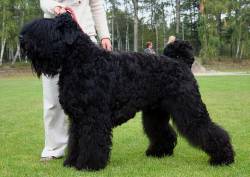 Russian Black Terrier
Russian Black Terrier
The ribcage should be deep, long and broad with an evident prosturnum or breast bone and lightly sprung oval ribs. Because of the dog's high withers, the topline slopes very slightly from the withers to the croup. The back should be should be strong and straight, ending in broad, slightly sloping arched loins of moderate length.The underline begins level or slightly below the elbow and the belly is moderately tucked up. The croup is broad and muscular, of a moderate length and slightly sloping. When undocked, the tail is sabre or sickle in shape.
When viewed from behind, the hind-legs are set wider than the forelegs and placed slightly behind the dog. The thighs are long, wide and well developed with voluminous muscles and well bent stifles. The lower (or second) thighs are no shorter than the upper thighs and the rear pasterns, strong, low and vertical without rear dewclaws. The hind feet are slightly smaller than the front feet and oval rather than round.
Coat
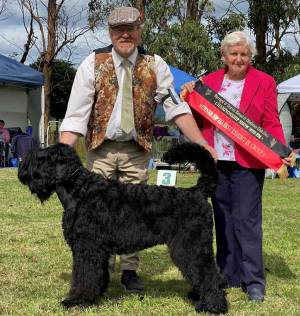 Russian Black Terrier as a Showdog
Russian Black Terrier as a Showdog
The Russian Black Terrier has a tight skin. It has a thick double coat which was originally designed to protect the dog from the extremes of weather which occur in Russia. When untrimmed, this dog has a thick, slightly wavy outer coat and a soft, short and dense undercoat which ranges from 5 to 15 cms in length. Abundant head furnishings form the eyebrows, moustach and beard. Consequently, shaping and grooming of the head is required.
Historically, the outer coat used to be hand stripped like its Airedale Terrier and Schnauzer(Giant) ancestors. However, today owners tend to clip and scissor the Russian Black Terrier which is an easier process. Whatever method is used the hair should be left longer on the legs and around the muzzle, with expert trimming on the head to accentuate the massive skull with the flat forehead and correctly placed ears.
References and Further Reading
[1] James Moore 'How One Woman Uncovered the Secret of Satlin's Killer Dog' published in the International Express (Britain) on Tuesday March 6, 2001 Page 31.
[2] Material supplied by Dorothy Sweeney